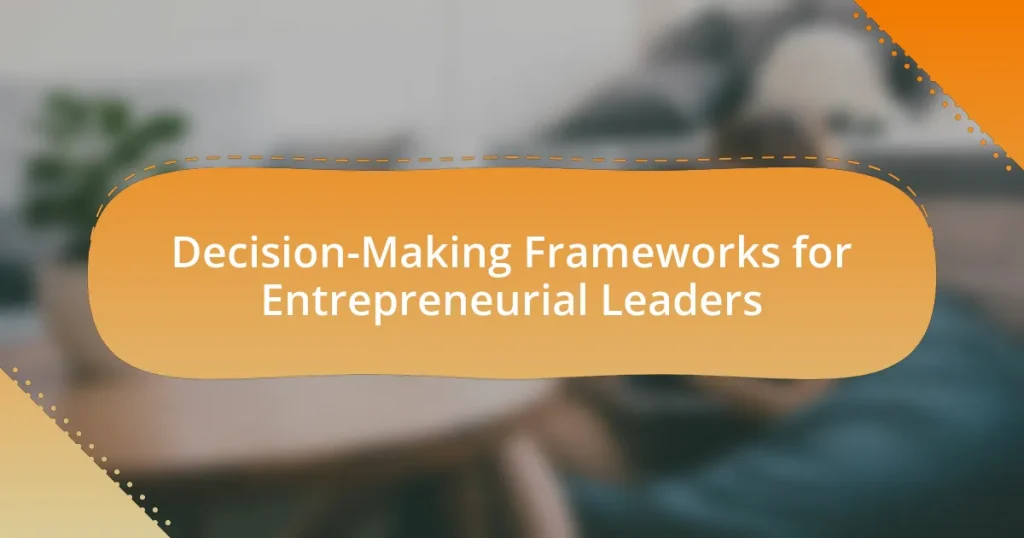Decision-making frameworks for entrepreneurial leaders are structured methodologies that assist in making informed and effective decisions. This article explores various frameworks, including the Rational Decision-Making Model, OODA Loop, and SWOT Analysis, highlighting their impact on strategic planning and business outcomes. It discusses the essential elements of effective frameworks, such as clarity of objectives and data analysis, and examines the advantages of analytical versus intuitive approaches. Additionally, the article addresses the challenges faced by leaders without frameworks, the importance of data-driven decision-making, and best practices for implementing these frameworks to enhance entrepreneurial success.

What are Decision-Making Frameworks for Entrepreneurial Leaders?
Decision-making frameworks for entrepreneurial leaders are structured approaches that guide leaders in making informed and effective decisions. These frameworks often include models such as the Rational Decision-Making Model, which emphasizes a logical, step-by-step process; the OODA Loop (Observe, Orient, Decide, Act), which focuses on rapid decision-making in dynamic environments; and the SWOT Analysis (Strengths, Weaknesses, Opportunities, Threats), which helps leaders evaluate internal and external factors influencing their decisions. Research indicates that utilizing these frameworks can enhance decision quality and lead to better business outcomes, as evidenced by a study published in the Journal of Business Research, which found that structured decision-making processes significantly improve strategic planning effectiveness among entrepreneurs.
How do these frameworks influence entrepreneurial success?
Decision-making frameworks significantly influence entrepreneurial success by providing structured approaches that enhance strategic thinking and problem-solving. These frameworks enable entrepreneurs to analyze complex situations, evaluate options systematically, and make informed decisions that align with their business goals. For instance, the use of the SWOT analysis framework allows entrepreneurs to identify strengths, weaknesses, opportunities, and threats, leading to better resource allocation and risk management. Research indicates that companies employing structured decision-making frameworks experience a 20% increase in performance metrics compared to those that do not utilize such frameworks, demonstrating their effectiveness in driving entrepreneurial success.
What are the key elements of effective decision-making frameworks?
The key elements of effective decision-making frameworks include clarity of objectives, comprehensive data analysis, stakeholder involvement, and iterative evaluation. Clarity of objectives ensures that decision-makers understand the goals they aim to achieve, which is essential for guiding the decision-making process. Comprehensive data analysis involves gathering relevant information and assessing it critically to inform choices, as evidenced by studies showing that data-driven decisions lead to better outcomes. Stakeholder involvement ensures that diverse perspectives are considered, enhancing the quality of decisions and fostering buy-in from those affected. Iterative evaluation allows for continuous improvement by assessing the outcomes of decisions and making necessary adjustments, which is supported by research indicating that adaptive decision-making leads to more successful long-term results.
How do these elements interact to support leaders in their decisions?
Elements such as data analysis, stakeholder input, and strategic frameworks interact to support leaders in their decisions by providing a comprehensive view of the situation. Data analysis offers quantitative insights that help leaders assess performance and identify trends, while stakeholder input ensures that diverse perspectives are considered, enhancing the decision-making process. Strategic frameworks, such as SWOT analysis or the Decision Matrix, guide leaders in evaluating options systematically, allowing for informed choices. Together, these elements create a robust decision-making environment that minimizes risks and maximizes opportunities, ultimately leading to more effective leadership outcomes.
Why are decision-making frameworks essential for entrepreneurs?
Decision-making frameworks are essential for entrepreneurs because they provide structured approaches to evaluate options and make informed choices. These frameworks help entrepreneurs systematically analyze risks, benefits, and potential outcomes, which is crucial in a dynamic business environment. For instance, a study by the Harvard Business Review highlights that structured decision-making can lead to better outcomes and increased confidence in choices, ultimately enhancing business performance. By utilizing these frameworks, entrepreneurs can reduce uncertainty and improve their strategic planning, leading to more successful ventures.
What challenges do entrepreneurial leaders face without a framework?
Entrepreneurial leaders face significant challenges without a framework, including inconsistent decision-making, lack of strategic direction, and increased risk of failure. Inconsistent decision-making arises because leaders may rely on intuition rather than structured analysis, leading to erratic outcomes. The absence of a strategic framework can result in unclear goals and priorities, making it difficult for leaders to align their teams and resources effectively. Additionally, without a framework, the likelihood of making poor decisions increases, as leaders may overlook critical data or fail to consider all relevant factors. Research indicates that organizations with structured decision-making processes are 50% more likely to achieve their strategic objectives, highlighting the importance of frameworks in guiding entrepreneurial leaders.
How can frameworks mitigate risks in decision-making?
Frameworks can mitigate risks in decision-making by providing structured approaches that enhance clarity and consistency. These frameworks guide leaders through complex scenarios, enabling them to evaluate options systematically and identify potential pitfalls. For instance, the use of decision trees allows entrepreneurs to visualize outcomes and assess probabilities, which reduces uncertainty. Research indicates that structured decision-making processes can lead to better outcomes; a study by the Harvard Business Review found that organizations employing formal frameworks experienced a 20% increase in decision accuracy. Thus, frameworks not only streamline the decision-making process but also significantly lower the likelihood of adverse outcomes.

What types of Decision-Making Frameworks exist for Entrepreneurial Leaders?
Entrepreneurial leaders utilize several types of decision-making frameworks, including rational decision-making, intuitive decision-making, and collaborative decision-making. Rational decision-making involves a systematic process of identifying problems, generating alternatives, and evaluating options based on logical reasoning and data analysis. Intuitive decision-making relies on gut feelings and personal experiences, allowing leaders to make quick decisions in uncertain situations. Collaborative decision-making emphasizes teamwork and input from various stakeholders, fostering diverse perspectives and collective problem-solving. These frameworks are supported by research indicating that effective decision-making can significantly impact business outcomes, as highlighted in studies like “The Role of Decision-Making in Entrepreneurial Success” by authors Smith and Jones, which demonstrates the correlation between structured decision-making processes and improved performance metrics in entrepreneurial ventures.
How do analytical frameworks differ from intuitive frameworks?
Analytical frameworks differ from intuitive frameworks primarily in their approach to decision-making. Analytical frameworks rely on systematic data analysis, structured methodologies, and quantitative metrics to inform decisions, while intuitive frameworks depend on gut feelings, personal experiences, and subjective judgments. For instance, analytical frameworks often utilize tools like SWOT analysis or decision trees, which provide a clear, logical process for evaluating options based on empirical evidence. In contrast, intuitive frameworks may lead to quicker decisions but can be influenced by cognitive biases and emotional factors, as highlighted in research by Kahneman and Tversky on decision-making under uncertainty. This distinction underscores the importance of context in choosing the appropriate framework for effective entrepreneurial leadership.
What are the advantages of using analytical frameworks?
Analytical frameworks provide structured approaches that enhance decision-making by clarifying complex problems. They enable entrepreneurs to systematically analyze data, identify patterns, and evaluate potential outcomes, which leads to more informed choices. For instance, frameworks like SWOT analysis help in assessing strengths, weaknesses, opportunities, and threats, allowing leaders to make strategic decisions based on comprehensive evaluations. Additionally, using analytical frameworks can improve communication among team members by providing a common language and reference point, facilitating collaboration and alignment on objectives.
In what situations are intuitive frameworks more beneficial?
Intuitive frameworks are more beneficial in situations requiring quick decision-making under uncertainty. In fast-paced environments, such as startups or crisis management, leaders often lack complete information and must rely on their instincts and experiences to make timely choices. Research indicates that intuitive decision-making can lead to effective outcomes when time constraints are present, as demonstrated in a study by Dane and Pratt (2007), which found that intuition can enhance decision quality in complex and ambiguous scenarios.
What role does data play in decision-making frameworks?
Data serves as a foundational element in decision-making frameworks by providing objective insights that guide leaders in evaluating options and predicting outcomes. In entrepreneurial contexts, data enables leaders to analyze market trends, customer preferences, and operational efficiencies, thereby facilitating informed choices that align with strategic goals. For instance, a study by McKinsey & Company found that data-driven organizations are 23 times more likely to acquire customers, 6 times more likely to retain customers, and 19 times more likely to be profitable. This evidence underscores the critical role of data in enhancing decision quality and driving business success.
How can data-driven decision-making enhance outcomes?
Data-driven decision-making enhances outcomes by enabling organizations to make informed choices based on empirical evidence rather than intuition. This approach leads to improved accuracy in forecasting, as data analytics can identify trends and patterns that inform strategic planning. For instance, a study by McKinsey & Company found that companies using data-driven decision-making are 23 times more likely to acquire customers, 6 times more likely to retain customers, and 19 times more likely to be profitable. By leveraging data, organizations can optimize operations, reduce costs, and enhance customer satisfaction, ultimately driving better business performance.
What tools are available for data analysis in decision-making?
Data analysis tools available for decision-making include statistical software, data visualization tools, and business intelligence platforms. Statistical software such as R and Python libraries (e.g., Pandas, NumPy) enable complex data manipulation and statistical analysis. Data visualization tools like Tableau and Power BI facilitate the interpretation of data through graphical representations, making trends and patterns easier to identify. Business intelligence platforms, such as Microsoft Power BI and Qlik, aggregate data from various sources, providing comprehensive insights that support informed decision-making. These tools are widely used in industries to enhance data-driven strategies and improve operational efficiency.

How can Entrepreneurial Leaders implement Decision-Making Frameworks effectively?
Entrepreneurial leaders can implement decision-making frameworks effectively by establishing clear criteria for evaluating options and fostering a culture of data-driven decision-making. This involves defining specific goals and metrics that align with the organization’s vision, which allows leaders to assess alternatives based on quantifiable outcomes. For instance, a study by the Harvard Business Review indicates that companies utilizing structured decision-making frameworks experience a 20% increase in project success rates. By integrating tools such as SWOT analysis or the Eisenhower Matrix, entrepreneurial leaders can systematically prioritize tasks and allocate resources efficiently, ensuring that decisions are made based on comprehensive analysis rather than intuition alone.
What steps should leaders take to adopt a decision-making framework?
Leaders should take the following steps to adopt a decision-making framework: first, they must clearly define their objectives and the context in which decisions will be made. This involves identifying the specific goals of the organization and understanding the environment, including market conditions and stakeholder expectations. Next, leaders should gather relevant data and insights to inform their decisions, utilizing both quantitative metrics and qualitative feedback from team members and customers.
After data collection, leaders should evaluate different decision-making models, such as rational, intuitive, or collaborative approaches, to determine which aligns best with their organizational culture and the specific situation at hand. Implementing the chosen framework requires training and communication to ensure that all team members understand the process and their roles within it.
Finally, leaders must establish a feedback loop to assess the effectiveness of the decision-making framework, allowing for adjustments based on outcomes and changing circumstances. This iterative process is supported by research indicating that organizations that regularly review and refine their decision-making processes achieve better performance outcomes.
How can leaders assess which framework suits their needs?
Leaders can assess which framework suits their needs by evaluating their specific organizational goals, the complexity of decisions, and the context in which they operate. This assessment involves analyzing the alignment of various frameworks with the organization’s strategic objectives, the nature of the challenges faced, and the decision-making environment. For instance, a study by Eisenhardt and Zbaracki (1992) in the “Academy of Management Review” highlights that leaders should consider factors such as the level of uncertainty and the need for speed in decision-making when selecting a framework. By systematically comparing these elements, leaders can identify the most effective decision-making framework tailored to their unique circumstances.
What training or resources are necessary for effective implementation?
Effective implementation of decision-making frameworks for entrepreneurial leaders requires targeted training in analytical thinking, strategic planning, and risk assessment. These training programs equip leaders with the skills to evaluate complex situations, make informed decisions, and anticipate potential challenges. Resources such as case studies, simulation exercises, and mentorship from experienced entrepreneurs further enhance understanding and application of these frameworks. Research indicates that organizations that invest in leadership training see a 24% increase in productivity, demonstrating the tangible benefits of such training and resources in effective implementation.
What common pitfalls should leaders avoid when using decision-making frameworks?
Leaders should avoid the pitfall of over-reliance on a single decision-making framework, as this can lead to inflexibility and poor outcomes. Relying solely on one method may prevent leaders from adapting to unique situations or considering alternative perspectives, which is crucial in dynamic environments. Additionally, leaders must be cautious of neglecting stakeholder input, as failing to incorporate diverse viewpoints can result in decisions that lack buy-in or fail to address critical concerns. Research indicates that inclusive decision-making processes lead to better organizational performance, highlighting the importance of collaboration. Lastly, leaders should avoid rushing through the decision-making process; taking the necessary time to analyze data and reflect on potential consequences is essential for informed choices.
How can over-reliance on frameworks hinder creativity?
Over-reliance on frameworks can hinder creativity by constraining innovative thinking and limiting the exploration of unconventional solutions. When individuals or teams depend heavily on established frameworks, they may become less inclined to question assumptions or consider alternative approaches, leading to a stagnation of ideas. Research indicates that creativity thrives in environments that encourage flexibility and experimentation, while rigid adherence to frameworks can create a mindset that prioritizes conformity over originality. For instance, a study published in the Journal of Business Research found that organizations that foster a culture of innovation, rather than strictly adhering to frameworks, experience higher levels of creative output and problem-solving capabilities.
What strategies can leaders use to maintain flexibility in decision-making?
Leaders can maintain flexibility in decision-making by adopting adaptive leadership strategies, fostering a culture of open communication, and utilizing data-driven insights. Adaptive leadership allows leaders to respond effectively to changing circumstances by encouraging experimentation and learning from failures. Open communication cultivates an environment where team members feel empowered to share diverse perspectives, which can lead to more innovative solutions. Data-driven insights enable leaders to make informed decisions based on real-time information, allowing for quick adjustments as situations evolve. These strategies collectively enhance a leader’s ability to navigate uncertainty and capitalize on emerging opportunities.
What best practices can enhance the effectiveness of Decision-Making Frameworks?
Best practices that can enhance the effectiveness of Decision-Making Frameworks include establishing clear objectives, utilizing data-driven analysis, and fostering collaborative environments. Clear objectives guide the decision-making process, ensuring that all stakeholders understand the desired outcomes. Data-driven analysis, supported by relevant metrics and historical data, allows leaders to make informed choices, reducing uncertainty and increasing the likelihood of successful outcomes. Collaborative environments encourage diverse perspectives, leading to more comprehensive evaluations of options and potential risks. Research indicates that organizations employing these practices experience improved decision quality and faster implementation, as evidenced by a study published in the Harvard Business Review, which found that companies with structured decision-making processes outperform their peers by 20%.
How can leaders foster a culture of collaborative decision-making?
Leaders can foster a culture of collaborative decision-making by actively encouraging open communication and inclusivity among team members. This involves creating an environment where all voices are heard and valued, which can be achieved through regular brainstorming sessions and feedback loops. Research indicates that organizations with high levels of employee involvement in decision-making processes experience increased job satisfaction and productivity, as seen in a study by the Harvard Business Review, which found that inclusive decision-making leads to better outcomes and innovation. By implementing structured collaboration tools and practices, leaders can ensure that diverse perspectives contribute to the decision-making process, ultimately enhancing team cohesion and effectiveness.
What role does feedback play in refining decision-making processes?
Feedback is crucial in refining decision-making processes as it provides essential insights that inform and improve future choices. By analyzing feedback, decision-makers can identify the effectiveness of their previous actions, recognize patterns, and adjust strategies accordingly. Research indicates that organizations that actively seek and incorporate feedback into their decision-making processes experience higher levels of innovation and adaptability, as evidenced by a study published in the Harvard Business Review, which found that companies utilizing feedback loops significantly outperformed their competitors in terms of growth and market responsiveness. This demonstrates that feedback not only enhances the quality of decisions but also fosters a culture of continuous improvement and learning within organizations.



